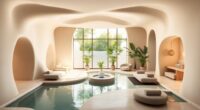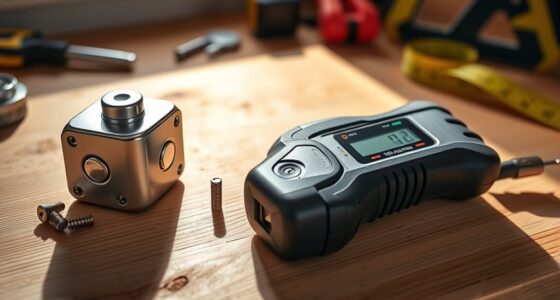A Dutch gable roof blends the benefits of both gable and hip roofs, giving you style and functionality. You'll enjoy increased natural light and ventilation, plus extra attic space for storage. This unique design boosts your home's curb appeal, enhancing property value. However, keep in mind the complexity of the structure can lead to higher construction and maintenance costs. It requires skilled labor for proper installation, and improper sealing might cause leaks. Weighing these pros and cons can help you decide if a Dutch gable roof fits your needs, and there's more to explore on this topic.
Key Takeaways
- Dutch gable roofs maximize natural light and ventilation, enhancing upper living spaces and improving indoor ambiance.
- Their unique design increases curb appeal and property value, making them attractive to homeowners.
- However, the complex structure leads to higher construction costs and requires skilled labor for installation.
- Maintenance demands are higher due to potential issues with snow accumulation and water leaks at joints.
- Compared to simpler roof designs, Dutch gable roofs may be more vulnerable to harsh weather conditions, necessitating careful planning.
Overview of Dutch Gable Roofs
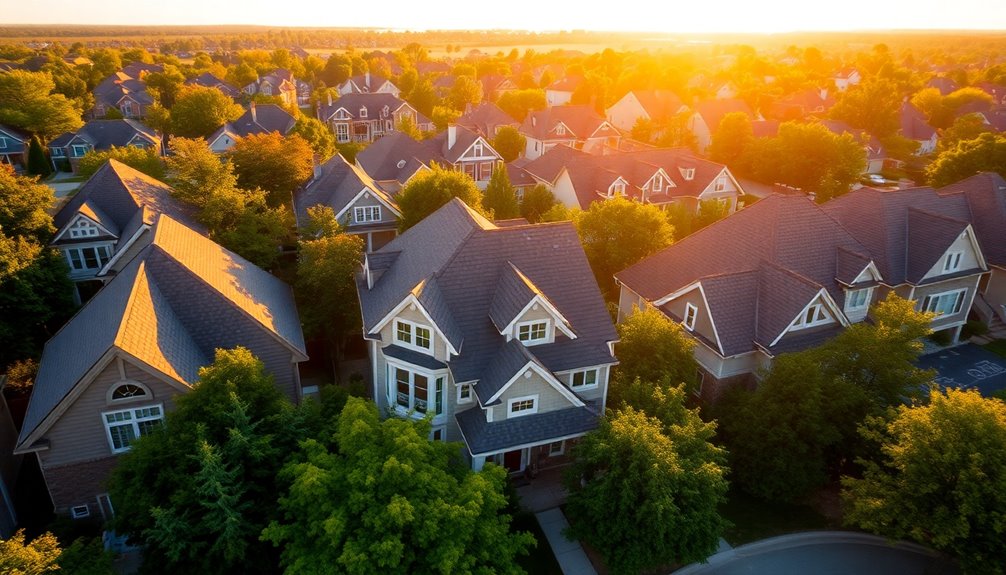
A Dutch gable roof is a unique architectural style that merges the features of hip and gable roofs, creating a visually appealing four-sloped design topped with a gablet.
This roofing style enhances aesthetics and curb appeal, making your home stand out. The gablet allows for increased natural light and ventilation, which not only brightens up the space but also improves air circulation.
You'll find that Dutch gable roofs offer greater attic space compared to traditional hip roofs, providing versatile options for storage or living areas.
Known for their structural stability and durability, these roofs can withstand various weather conditions when properly maintained.
Advantages of Dutch Gable Roofs
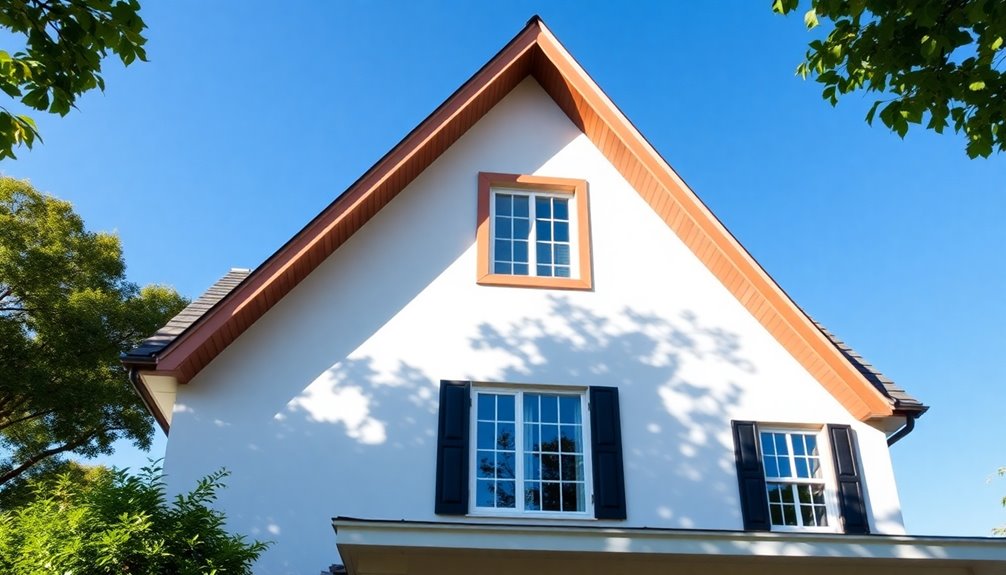
When you choose a Dutch gable roof, you're not just enhancing your home's look; you're also inviting more natural light into your upper spaces.
The design adds extra storage options, maximizing your home's functionality.
Plus, that unique style can boost your curb appeal and potentially raise your property value.
Increased Natural Light
Dutch gable roofs are a fantastic choice for homeowners looking to enhance natural light in their living spaces.
With their unique design, you can enjoy several benefits:
- Gablets for Windows: These roofs allow for windows that greatly boost natural light in upper levels.
- Vaulted Ceilings: The higher ceilings create a bright, spacious feel in your rooms.
- Improved Ventilation: Better airflow helps regulate indoor temperatures, enhancing comfort and energy efficiency.
- Additional Attic Space: This space can accommodate skylights or dormer windows, further increasing natural light.
Additionally, the design of a Dutch gable roof can also contribute to better airflow by promoting natural ventilation throughout the home, similar to how effective air purifiers improve indoor air quality.
Enhanced Aesthetic Appeal
While exploring roofing options, you'll find that Dutch gable roofs offer a striking aesthetic appeal that can transform the look of your home. Their unique combination of hip and gable designs creates a visually striking silhouette, enhancing curb appeal and setting your property apart. The gablet allows for windows, increasing natural light in your upper living spaces. This versatile style complements various architectural designs, making it a popular choice for homeowners wanting to boost their property's beauty and value. With a blend of traditional and modern elements, Dutch gable roofs not only elevate your home's style but can also contribute to increased property value.
| Feature | Benefit | Impact |
|---|---|---|
| Gable Design | Enhanced curb appeal | Visually striking |
| Gablet Windows | Increased natural light | Improved ambiance |
| Architectural Versatility | Complements various styles | Broader appeal |
| Unique Silhouette | Elegant architectural statement | Distinction in neighborhood |
| Traditional + Modern | Higher property value | Investment potential |
Additional Storage Space
One of the standout benefits of a Dutch gable roof is the additional storage space it offers, making it an appealing choice for homeowners.
With this design, you can maximize your attic space in several ways:
- Built-in shelving: Create easy organization for seasonal items.
- Living areas: Transform the attic into a cozy retreat or office.
- Natural light: Install windows to brighten the space, enhancing usability.
- Ventilation: Improved airflow contributes to energy savings and comfort.
The increased height not only allows for better airflow but also makes the attic more inviting.
By utilizing this additional storage space, you can reduce clutter in your home, ultimately improving overall organization and functionality.
Dutch gable roofs truly enhance your living experience!
Disadvantages of Dutch Gable Roofs
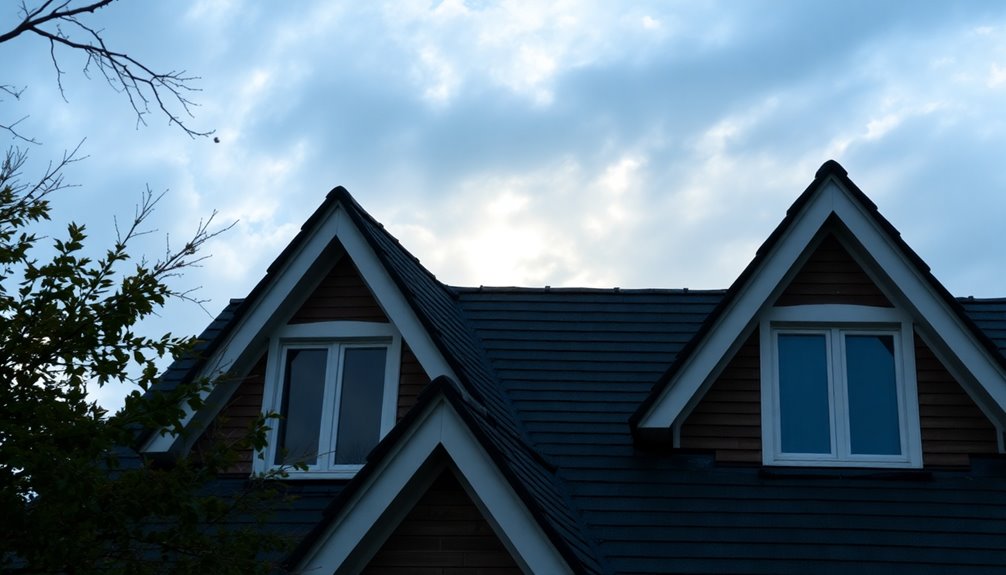
Although Dutch gable roofs are visually appealing, they come with several disadvantages that can impact your building project.
Their complex structure requires more materials and skilled labor, leading to higher construction costs than simpler roof types. You must also be cautious about the joints between the gable and hip sections, as improper sealing can result in water damage and leaks.
Regular maintenance is essential to address potential issues such as snow accumulation, making these roofs more demanding to upkeep. Additionally, the intricate design may need extra structural supports, further complicating construction.
Finally, their vulnerability to harsh weather conditions means careful design and installation are necessary to withstand elements like high winds and heavy rainfall.
Comparison With Other Roof Types
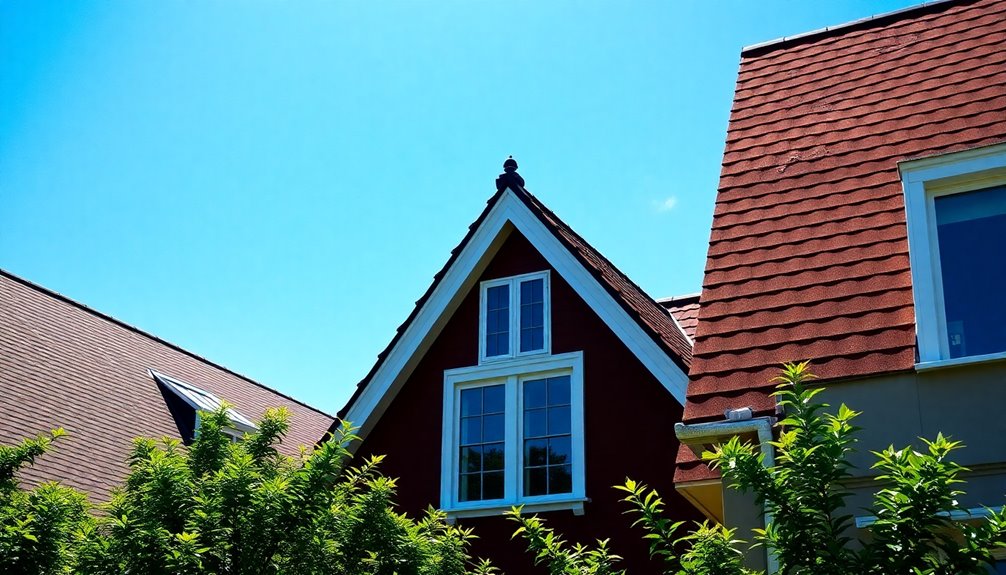
The complexities of Dutch gable roofs set them apart when compared to other roof types, making it important to weigh their unique features against alternatives.
Here's a quick comparison:
- Dutch gable roofs combine advantages of both hip and gable roofs, offering aesthetic appeal and maximizing natural sunlight.
- Hip roofs provide superior structural integrity and stability in high winds, which may come at a lower construction cost.
- Gable roofs allow for simpler, cost-effective designs but often lack the versatility and ventilation options of Dutch gables.
- Maintenance requirements for Dutch gables are higher due to their complex design and need for careful sealing to prevent water damage.
Ultimately, your choice will depend on your priorities regarding aesthetics, durability, and upkeep.
Construction Considerations
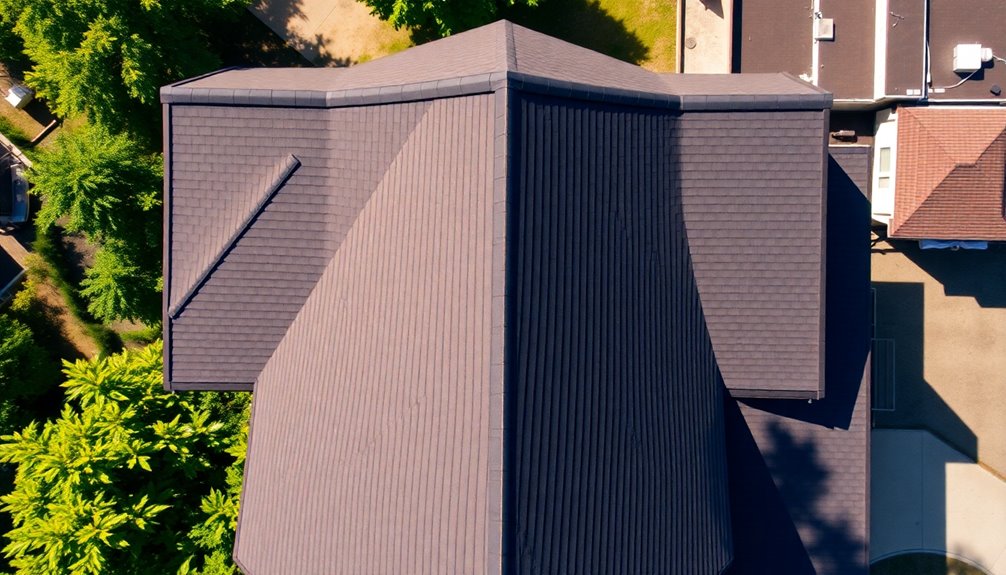
When constructing a Dutch gable roof, you need to contemplate the intricate design that demands skilled craftsmanship. This complex design involves multiple pitches, requiring careful planning and additional materials for waterproofing.
You must assess structural support to guarantee even weight distribution, as the unique shape can pose challenges. It's essential to review local building codes to comply with specific regulations governing Dutch gable roofs.
Additionally, the gablet construction resembles adding an extra structure, which necessitates meticulous sealing to prevent water accumulation and potential leaks at joints.
Neglecting these construction considerations can lead to significant issues down the line, so take the time to plan thoroughly and execute the build with precision for a successful roofing project.
Maintenance and Durability
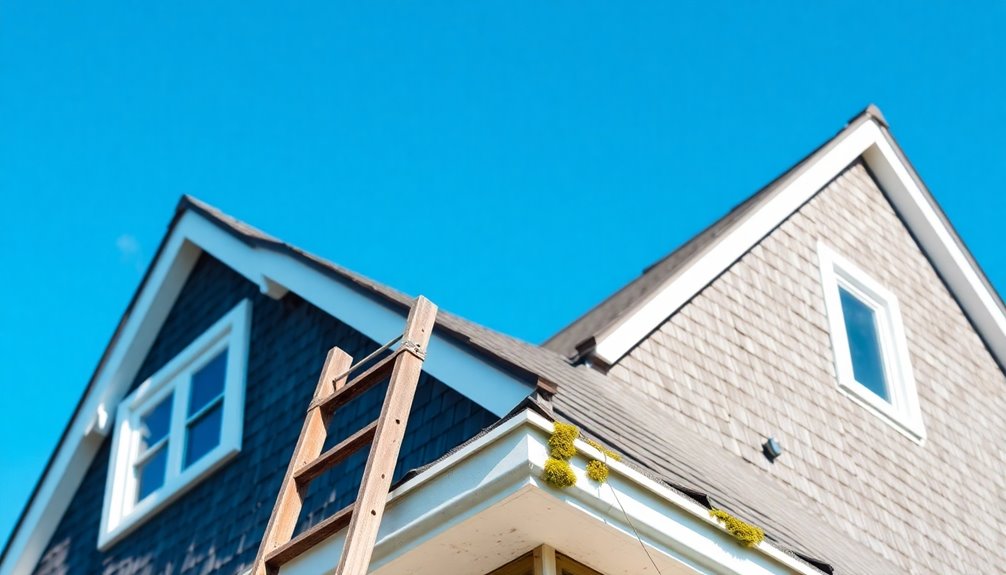
After ensuring your Dutch gable roof is constructed correctly, ongoing maintenance plays a significant role in its longevity and performance.
Regular inspections are crucial to catch potential leaks, especially at the gable and hip joints. The choice of roofing materials impacts durability; metal roofing excels in resisting water infiltration compared to asphalt shingles.
To keep your roof in top shape, consider these tips:
- Inspect joints for leaks regularly.
- Maintain proper drainage systems to avoid water accumulation.
- Use specialized sealing techniques for waterproofing.
- Address any structural issues promptly.
Investing in maintenance now helps prevent costly repairs later, ensuring your Dutch gable roof withstands various weather conditions effectively.
Frequently Asked Questions
What Are the Disadvantages of a Dutch Gable Roof?
When considering a Dutch gable roof, you should be aware of several disadvantages.
It requires more materials and labor, driving up construction costs. The complex design can lead to water damage if joints aren't sealed properly.
Maintenance becomes trickier, as the intricate structure may develop more problem areas over time.
Additionally, the unique shape might make it less resilient to severe weather, increasing the risk of damage from high winds and heavy snow.
What Is the Purpose of a Dutch Gable Roof?
You might think a roof's just a roof, but a Dutch gable roof serves multiple purposes.
It combines the durability of hip roofs with the style of gable roofs, giving you both functionality and aesthetic appeal.
The design allows for added attic space and natural light through windows, enhancing your living environment.
Plus, it improves ventilation and can boost your home's energy efficiency, making it a smart choice for any homeowner.
What Are the Cons of Gable Roofs?
When considering gable roofs, you should be aware of several drawbacks. They can be more vulnerable to wind damage, especially in high-wind areas, which might lead to structural issues.
You might also find that their limited pitch angles restrict ceiling height, making upper spaces less usable. While maintenance is generally low, periodic inspections are still necessary to avoid leaks and structural problems.
Ultimately, their simple design can limit your options for unique architectural features.
What Is a Popular Roof Style but Is More Difficult to Build Than the Gable?
If you're looking for a popular roof style that's more challenging to build than a gable, consider the Dutch gable roof.
This design combines the elements of hip and gable roofs, creating a unique aesthetic. However, it requires skilled labor and additional materials, making it more complex and costly to construct.
You'll need to guarantee proper planning to avoid structural issues and water damage, which adds to the project's overall difficulty.
Conclusion
To summarize, Dutch gable roofs blend elegance and functionality, offering you a stylish yet practical choice for your home. While some might worry about the complexity of construction, skilled builders can efficiently handle the design, ensuring you get the stunning aesthetic without excessive hassle. Plus, their increased attic space can be a game-changer for storage or living areas. Embracing a Dutch gable roof not only enhances your home's curb appeal but also boosts its overall value.

